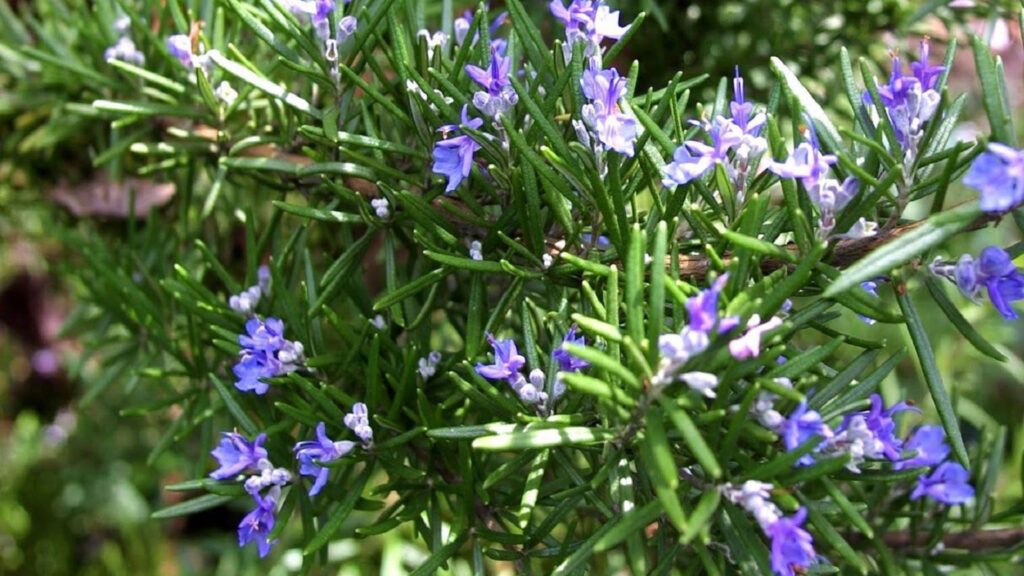Rosmarino
(FAMIGLIA LAMIACEAE)
E’ una pianta sempreverde tipica della macchia mediterranea, si trova sia vicino al mare sia in terreni sub montani, in substrati calcarei o granitici.
Puo’ arrivare fino a 2,5 mt in altezza , presenta un fusto robusto con rametti eretti ascendenti. Assieme al cisto e all’elicriso invade l’aria col suo profumo intenso “DI SARDEGNA”, i suoi rametti in fiore colorano le cerimonie campestri e fanno da letto a carni e arrosti conferendo un sapore inconfondibile alle pietanze.
In Sardegna viene ancora usato come spiedo per far rosolare alla brace “LA RIVEA” fatta da frattaglie di capretto o agnello insaporite e raccolte da un intreccio di interiora.
Da sempre considerato un buon rimedio per molti mali, in epoca medioevale era coltivato nei giardini e usato per scacciare gli spiriti maligni. Per gli egiziani era simbolo di immortalità, infatti durante i riti funebri deponevano dei rametti di rosmarino nelle mani del defunto perché fosse di aiuto durante il viaggio nell’ oltretomba. Per i romani era simbolo dell’amore, considerato un dono fatto agli uomini da Afrodite, pianta sempre presente nelle cerimonie religiose e nelle feste nuziali dove le giovani spose offrivano agli invitatidel vino al rosmarino.
Gli anziani raccontano che le spose nel giorno del matrimonio portavano sulla testa una corona di rosmarino affinche’ il colore verde semprevivo fosse di buon augurio alla famiglia. La pianta e’ usata in fitoterapia per il potere astringente, antisettico, antiparassitario, mentre in aroma terapia combatte l’emicrania la depressione e migliorare la memoria.
Rosemary
(LAMIACEAE FAMILY)
It is an evergreen plant typical of the Mediterranean scrub, it is found both near the sea and in submontane soils, in calcareous or granite substrates.
It can reach up to 2.5 meters in height, has a sturdy stem with erect ascending branches. Together with the rockrose and the helichrysum it invades the air with its intense “DI SARDEGNA” scent, its blooming twigs color the country ceremonies are the bed for meats and roasts giving an unmistakable flavor to the dishes. In Sardinia it is still used as a spit to brown “LA RIVEA” on the grill, made from goat or lamb offal seasoned and gathered from an intertwining of entrails.
Always considered a good remedy for many ills, in medieval times it was cultivated in gardens and used to drive away evil spirits. For the Egyptians it was a symbol of immortality, in fact during the funeral rites they placed sprigs of rosemary in the hands of the deceased to help them during the journey to the afterlife.
For the Romans it was a symbol of love, considered a gift given to men by Aphrodite, a plant always present in religious ceremonies and wedding feasts where young brides offered rosemary wine to guests.
The elders say that the brides on the wedding day wore a rosemary crown on their heads so that the everlasting green color was a good omen to the family.
The plant is used in herbal medicine for its astringent, antiseptic, pesticide power, while in aromatherapy it fights migraines, depression and improves memory.
Romarin
(FAMILLE LAMIACEAE)
C’est une plante persistante typique du maquis méditerranéen, on la trouve aussi bien près de la mer que dans les sols submontagnards, dans les substrats calcaires ou granitiques.
Il peut arriver jusqu’à 2,5 mètres de hauteur, a une tige robuste avec des branches ascendantes dressées. Avec le ciste et l’hélichryse, il envahit l’air de son intense parfum “DI SARDEGNA”, ses brindilles épanouies colorent les cérémonies champêtres et servent de lit aux viandes et rôtis donnant une saveur incomparable aux plats.
En Sardaigne on l’utilise encore comme broche à dorer “LA RIVEA” sur le gril, à base d’abats de chèvre ou d’agneau assaisonnés et recueillis à partir d’un entrelacement d’entrailles. Toujours considérée comme un bon remède à de nombreux maux, elle était à l’époque médiévale cultivée dans les jardins et utilisée pour chasser les mauvais esprits.
Pour les Égyptiens c’était un symbole d’immortalité, en effet lors des rites funéraires ils plaçaient des brins de romarin dans les mains du défunt pour les aider pendant le voyage vers l’au-delà. Pour les Romains, c’était un symbole d’amour, considéré comme un cadeau offert aux hommes par Aphrodite, une plante toujours présente dans les cérémonies religieuses et les fêtes de mariage où les jeunes mariées offraient du vin de romarin aux invités.
Les anciens disent que les mariées portaient le jour du mariage une couronne de romarin sur la tête afin que la couleur verte éternelle soit de bon augure pour la famille. La plante est utilisée en phytothérapie pour son pouvoir astringent, antiseptique, pesticide, tandis qu’en aromathérapie elle combat les migraines, la dépression et améliore la mémoire.



